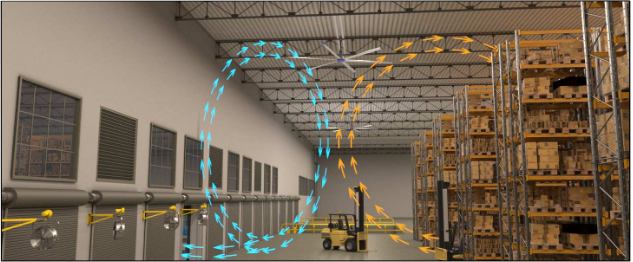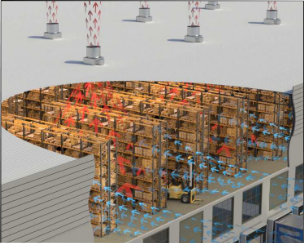As the COVID-19 pandemic continues to impact our society, all of us look to the future with the hope that it is merely a temporary setback. While mitigations and restrictions are starting to be repealed and are tapering off, one trend that has not slowed down is online shopping. Consumers enjoy the convenience, seemingly endless selection, and safety of purchasing online. In fact, E-Commerce grew to 21% of all retail sales in 2020.1 With this increase in commerce, the amount of warehouse space necessary is also greatly increasing. E-Commerce requires three times the amount of warehouse space as a traditional brick and mortar retail operation.2
With the increased demand for warehouse space, owners are facing a new set of challenges as well. Employee safety and comfort have become a priority as the demand for workers has increased. A well-designed HVAC system can help provide both items, without costing the owner too much money.
Throughout the pandemic, it has been well documented that increased ventilation provides protection against contagious diseases as well as removing airborne pollutants. Many of these distribution centers add an additional factor that many do not seem to contemplate: vehicle exhaust. Modern distribution and fulfillment warehouses emphasizing last-mile delivery often bring delivery vans into the facility, adding harmful fumes and other pollutants.3 Using proper HVAC equipment to bring in fresh outside air and proper air circulation can efficiently dilute and remove these pollutants.
Proper air ventilation also improves occupant safety by keeping employees productive and alert. Employees who are too hot or too cold do not function at peak performance. Overheating can lead to sweating, fatigue, and poor decision making. Proper air circulation can help maintain dry floors and surfaces, reducing the number of potential falls. Depending on the geographic location and seasons, these issues can persist most of the year round.
Make-Up Air
Knowing the benefits of increased ventilation for warehouses is only half the battle – the rest is choosing the correct system to implement it. First, let’s focus on the winter season, where heating is what is most required. Direct gas heating is the most commonly used heating method, with its high thermal efficiency (92%), low first cost and compact footprint.4 Units are typically in one of two configurations: 100% outside air and a recirculating unit, usually referred to as an 80/20 unit due to its 20% of outside air.
The 100% outside air units have a higher discharge temperature and larger amount of outside air for pollutant dilution and a cheaper upfront cost, while the recirculating units offer better ability to adjust the amount of outside air coming into the space, which helps with greater control of building pressure and temperature.

Figure 2: 80/20 units offer better control of temperature and building pressure with a drawback of higher upfront cost
Destratification
Discharging all this warm air into a warehouse does not do much good if it remains along the roof and not in the occupied zone. The warm air will stratify, which is the result of warm air’s natural tendency to rise. Luckily, there is equipment available to help with occupant comfort without breaking the bank – the HVLS fan.
HVLS fans, which stands for High Velocity Low Speed, do an exceptional job of keeping air circulating in high ceiling, high volume spaces. During winter months, the HVLS fans prevent the stratification of air, and can save up to 25% in heating costs. In the summer seasons, the air circulation promoted by the HVLS fans can reduce AC costs in warehouses by as much as 30% by reducing the amount of run time for AC equipment or allowing the occupants to increase the setpoint.5 Even in warehouses without AC equipment, the HVLS fans still help provide comfort through the continuous movement of air, providing a cooling effect of 10 degrees.
Ventilation
Not all warehouses are equipped with equipment to condition the air, and due to their age, the retrofit costs on many prohibit installing such equipment. Most summer ventilation and conditioning of warehouses is achieved through the combination of roof mounted exhaust fans and louvers on the perimeter walls of the building.
The exhaust fans and intake louvers remove heat from the building, which usually accumulates along the roof deck. That warm air is replaced with cooler air that comes into the building, low along the perimeter. The constant turnover of air not only removes the heat from the building, but also any airborne pollutants that may be accumulating. Typical air ventilation rates for warehouse spaces are between 1 to 3 air changes per hour.
Whether your system is using HVLS fans, a combination of roof mounted exhaust fans and louvers, direct fired or indirect fired make up air equipment, your Brucker representative and Greenheck can help you design and implement an effective system to keep your employees safe and comfortable for years to come.
References:
- (Greenheck Corporation, February 2022). Warehouse Ventilation Strategies and Design Considerations
- (Prologis, June 2020). Covid-19 Special Report #6: Accelerated Retail Evolution Could Bolster Demand For Well-Located Logistics Space
- (Greenheck Corporation, Butina S., January 2021). Addressing Two Trends that will Strain Efficiency in the Warehouse
- (Greenheck Corporation, Dane T., May 2021). Benefits of Heating Warehouses with Direct Gas-Fired Equipment
- (Greenheck Corporation, February 2022). Warehouse Ventilation Strategies and Design Considerations




Recent Comments